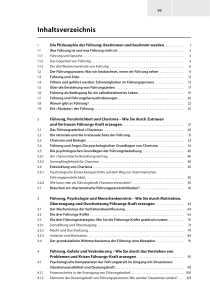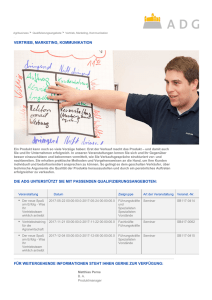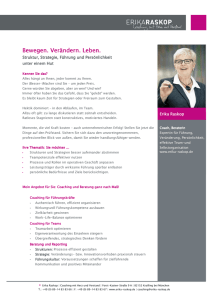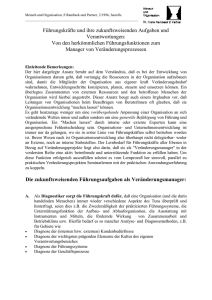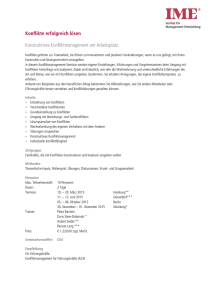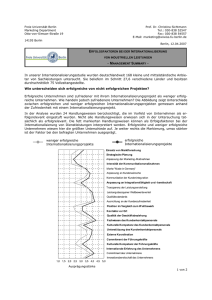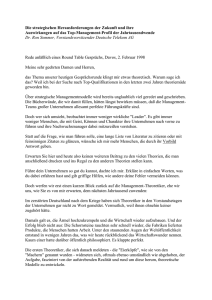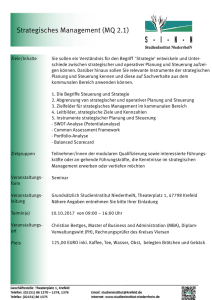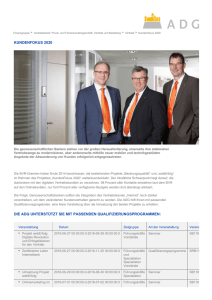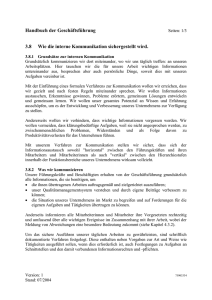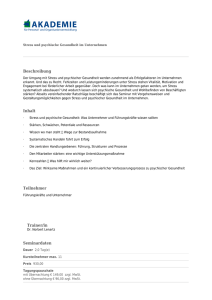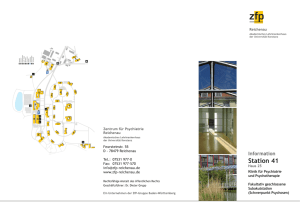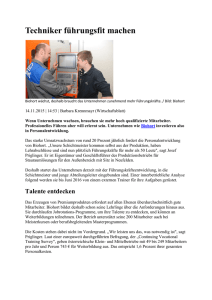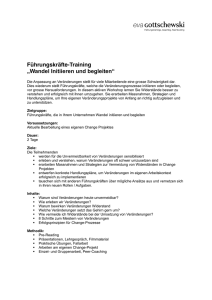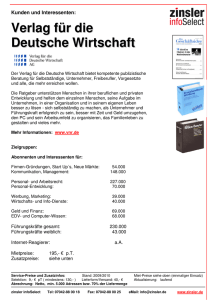Inhaltsverzeichnis
Werbung
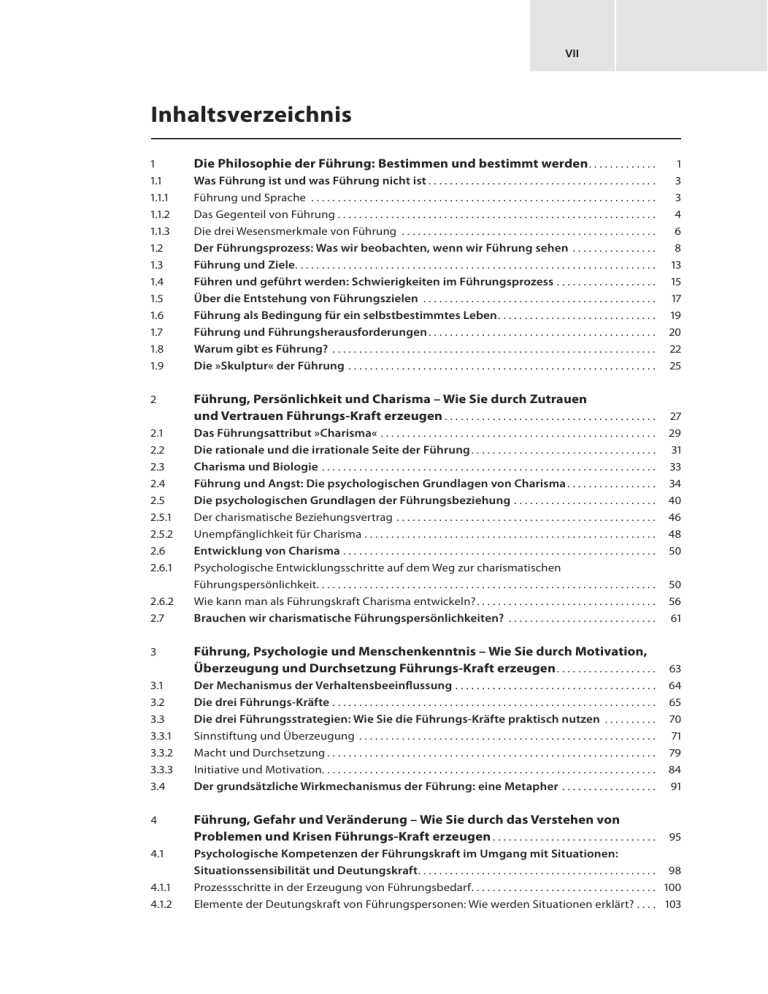
VII Inhaltsverzeichnis 1 1.1 1.1.1 1.1.2 1.1.3 1.2 1.3 1.4 1.5 1.6 1.7 1.8 1.9 Die Philosophie der Führung: Bestimmen und bestimmt werden . . . . . . . . . . . . . Was Führung ist und was Führung nicht ist . . . . . . . . . . . . . . . . . . . . . . . . . . . . . . . . . . . . . . . . . . . Führung und Sprache . . . . . . . . . . . . . . . . . . . . . . . . . . . . . . . . . . . . . . . . . . . . . . . . . . . . . . . . . . . . . . . . . Das Gegenteil von Führung . . . . . . . . . . . . . . . . . . . . . . . . . . . . . . . . . . . . . . . . . . . . . . . . . . . . . . . . . . . . Die drei Wesensmerkmale von Führung . . . . . . . . . . . . . . . . . . . . . . . . . . . . . . . . . . . . . . . . . . . . . . . . Der Führungsprozess: Was wir beobachten, wenn wir Führung sehen . . . . . . . . . . . . . . . . Führung und Ziele. . . . . . . . . . . . . . . . . . . . . . . . . . . . . . . . . . . . . . . . . . . . . . . . . . . . . . . . . . . . . . . . . . . . Führen und geführt werden: Schwierigkeiten im Führungsprozess . . . . . . . . . . . . . . . . . . . Über die Entstehung von Führungszielen . . . . . . . . . . . . . . . . . . . . . . . . . . . . . . . . . . . . . . . . . . . . Führung als Bedingung für ein selbstbestimmtes Leben . . . . . . . . . . . . . . . . . . . . . . . . . . . . . . Führung und Führungsherausforderungen . . . . . . . . . . . . . . . . . . . . . . . . . . . . . . . . . . . . . . . . . . . Warum gibt es Führung? . . . . . . . . . . . . . . . . . . . . . . . . . . . . . . . . . . . . . . . . . . . . . . . . . . . . . . . . . . . . . Die »Skulptur« der Führung . . . . . . . . . . . . . . . . . . . . . . . . . . . . . . . . . . . . . . . . . . . . . . . . . . . . . . . . . . 2 Führung, Persönlichkeit und Charisma – Wie Sie durch Zutrauen und Vertrauen Führungs-Kraft erzeugen . . . . . . . . . . . . . . . . . . . . . . . . . . . . . . . . . . . . . . . . 2.1 2.2 2.3 2.4 2.5 2.5.1 2.5.2 2.6 2.6.1 Das Führungsattribut »Charisma« . . . . . . . . . . . . . . . . . . . . . . . . . . . . . . . . . . . . . . . . . . . . . . . . . . . . Die rationale und die irrationale Seite der Führung . . . . . . . . . . . . . . . . . . . . . . . . . . . . . . . . . . . Charisma und Biologie . . . . . . . . . . . . . . . . . . . . . . . . . . . . . . . . . . . . . . . . . . . . . . . . . . . . . . . . . . . . . . . Führung und Angst: Die psychologischen Grundlagen von Charisma . . . . . . . . . . . . . . . . . Die psychologischen Grundlagen der Führungsbeziehung . . . . . . . . . . . . . . . . . . . . . . . . . . . Der charismatische Beziehungsvertrag . . . . . . . . . . . . . . . . . . . . . . . . . . . . . . . . . . . . . . . . . . . . . . . . . Unempfänglichkeit für Charisma . . . . . . . . . . . . . . . . . . . . . . . . . . . . . . . . . . . . . . . . . . . . . . . . . . . . . . . Entwicklung von Charisma . . . . . . . . . . . . . . . . . . . . . . . . . . . . . . . . . . . . . . . . . . . . . . . . . . . . . . . . . . . Psychologische Entwicklungsschritte auf dem Weg zur charismatischen Führungspersönlichkeit. . . . . . . . . . . . . . . . . . . . . . . . . . . . . . . . . . . . . . . . . . . . . . . . . . . . . . . . . . . . . . . . Wie kann man als Führungskraft Charisma entwickeln? . . . . . . . . . . . . . . . . . . . . . . . . . . . . . . . . . . Brauchen wir charismatische Führungspersönlichkeiten? . . . . . . . . . . . . . . . . . . . . . . . . . . . . 2.6.2 2.7 1 3 3 4 6 8 13 15 17 19 20 22 25 27 29 31 33 34 40 46 48 50 50 56 61 3 Führung, Psychologie und Menschenkenntnis – Wie Sie durch Motivation, Überzeugung und Durchsetzung Führungs-Kraft erzeugen . . . . . . . . . . . . . . . . . . . 3.1 3.2 3.3 3.3.1 3.3.2 3.3.3 3.4 Der Mechanismus der Verhaltensbeeinflussung . . . . . . . . . . . . . . . . . . . . . . . . . . . . . . . . . . . . . . Die drei Führungs-Kräfte . . . . . . . . . . . . . . . . . . . . . . . . . . . . . . . . . . . . . . . . . . . . . . . . . . . . . . . . . . . . . Die drei Führungsstrategien: Wie Sie die Führungs-Kräfte praktisch nutzen . . . . . . . . . . Sinnstiftung und Überzeugung . . . . . . . . . . . . . . . . . . . . . . . . . . . . . . . . . . . . . . . . . . . . . . . . . . . . . . . . Macht und Durchsetzung . . . . . . . . . . . . . . . . . . . . . . . . . . . . . . . . . . . . . . . . . . . . . . . . . . . . . . . . . . . . . . Initiative und Motivation. . . . . . . . . . . . . . . . . . . . . . . . . . . . . . . . . . . . . . . . . . . . . . . . . . . . . . . . . . . . . . . Der grundsätzliche Wirkmechanismus der Führung: eine Metapher . . . . . . . . . . . . . . . . . . 4 Führung, Gefahr und Veränderung – Wie Sie durch das Verstehen von Problemen und Krisen Führungs-Kraft erzeugen . . . . . . . . . . . . . . . . . . . . . . . . . . . . . . . 95 4.1 Psychologische Kompetenzen der Führungskraft im Umgang mit Situationen: Situationssensibilität und Deutungskraft. . . . . . . . . . . . . . . . . . . . . . . . . . . . . . . . . . . . . . . . . . . . . 98 Prozessschritte in der Erzeugung von Führungsbedarf . . . . . . . . . . . . . . . . . . . . . . . . . . . . . . . . . . . 100 Elemente der Deutungskraft von Führungspersonen: Wie werden Situationen erklärt? . . . . 103 4.1.1 4.1.2 63 64 65 70 71 79 84 91 VIII Inhaltsverzeichnis 4.1.3 4.2 4.3 Erklärung und Deutung von Situationen durch die Nutzung von Metaphern . . . . . . . . . . . . . . 105 Situation und Ziele . . . . . . . . . . . . . . . . . . . . . . . . . . . . . . . . . . . . . . . . . . . . . . . . . . . . . . . . . . . . . . . . . . . 106 5 Führung, Herausforderung und Perspektive – Wie Sie durch anspornende und verlockende Ziele Führungskraft erzeugen . . . . . . . . . . . . . . . . . 113 5.1 5.1.1 5.1.2 5.1.3 Über den Charakter von Zielen . . . . . . . . . . . . . . . . . . . . . . . . . . . . . . . . . . . . . . . . . . . . . . . . . . . . . . . . Thesen über das wahre Wesen von Zielen in der Führung . . . . . . . . . . . . . . . . . . . . . . . . . . . . . . . . . Über die Missverständnisse vieler typischer Zielvereinbarungssysteme . . . . . . . . . . . . . . . . . . . Das 3-V-Modell der Zielkriterien: Kriterien von Zielen, die Führungs-Kraft auslösen können . . . . . . . . . . . . . . . . . . . . . . . . . . . . . . . . . . . . . . . . . . . . . . . . . . . . . . . . . . . . . . . . . . . . . . 5.2 5.3 5.4 Von der Krise zur Grausamkeit . . . . . . . . . . . . . . . . . . . . . . . . . . . . . . . . . . . . . . . . . . . . . . . . . . . . . . . 109 115 115 118 120 Ursprung und Arten von Zielen . . . . . . . . . . . . . . . . . . . . . . . . . . . . . . . . . . . . . . . . . . . . . . . . . . . . . . . 121 Ziele und Delegation . . . . . . . . . . . . . . . . . . . . . . . . . . . . . . . . . . . . . . . . . . . . . . . . . . . . . . . . . . . . . . . . . 124 Ziele in der Politik . . . . . . . . . . . . . . . . . . . . . . . . . . . . . . . . . . . . . . . . . . . . . . . . . . . . . . . . . . . . . . . . . . . . 126 6 Führung, Kultur und Gewohnheit – Wie Sie durch die Schaffung von Strukturen Führungs-Kraft erzeugen . . . . . . . . . . . . . . . . . . . . . . . . . . . . . . . . . . . . . . . 129 6.1 6.1.1 6.1.2 6.1.3 6.1.4 6.2 6.3 6.3.1 6.3.2 Die Wirkungsweise von Strukturen . . . . . . . . . . . . . . . . . . . . . . . . . . . . . . . . . . . . . . . . . . . . . . . . . . . Innere und äußere Strukturen . . . . . . . . . . . . . . . . . . . . . . . . . . . . . . . . . . . . . . . . . . . . . . . . . . . . . . . . . . Über das Wesen von Führungsstrukturen . . . . . . . . . . . . . . . . . . . . . . . . . . . . . . . . . . . . . . . . . . . . . . . Schaffung von Führungsstrukturen . . . . . . . . . . . . . . . . . . . . . . . . . . . . . . . . . . . . . . . . . . . . . . . . . . . . . Führung und Führungseffizienz . . . . . . . . . . . . . . . . . . . . . . . . . . . . . . . . . . . . . . . . . . . . . . . . . . . . . . . . Führungsprobleme und Führungsstruktur . . . . . . . . . . . . . . . . . . . . . . . . . . . . . . . . . . . . . . . . . . . Veränderung von Strukturen . . . . . . . . . . . . . . . . . . . . . . . . . . . . . . . . . . . . . . . . . . . . . . . . . . . . . . . . . Was macht Veränderungen so schwierig? . . . . . . . . . . . . . . . . . . . . . . . . . . . . . . . . . . . . . . . . . . . . . . . Hinweise für die erfolgreiche Umsetzung von Veränderungen . . . . . . . . . . . . . . . . . . . . . . . . . . . 7 Führung, Gruppe und Dynamik – Wie Sie in Konfliktsituationen Führungs-Kraft erzeugen . . . . . . . . . . . . . . . . . . . . . . . . . . . . . . . . . . . . . . . . . . . . . . . . . . . . . . . . . 149 7.1 7.1.1 7.1.2 7.1.3 7.1.4 7.2 7.2.1 7.2.2 7.2.3 7.3 7.4 Psychologische Ursachen von Konflikten . . . . . . . . . . . . . . . . . . . . . . . . . . . . . . . . . . . . . . . . . . . . . . Konflikte und Beziehungen . . . . . . . . . . . . . . . . . . . . . . . . . . . . . . . . . . . . . . . . . . . . . . . . . . . . . . . . . . . . Konflikte und Rollen . . . . . . . . . . . . . . . . . . . . . . . . . . . . . . . . . . . . . . . . . . . . . . . . . . . . . . . . . . . . . . . . . . . Verschärfende Bedingungen in Konflikten . . . . . . . . . . . . . . . . . . . . . . . . . . . . . . . . . . . . . . . . . . . . . . Ziele erfolgreichen Konfliktmanagements . . . . . . . . . . . . . . . . . . . . . . . . . . . . . . . . . . . . . . . . . . . . . . Konflikte und Konfliktmanagement in der Führung . . . . . . . . . . . . . . . . . . . . . . . . . . . . . . . . . . Konfliktmanagement als Führungsleistung . . . . . . . . . . . . . . . . . . . . . . . . . . . . . . . . . . . . . . . . . . . . . Phasen in der Entwicklung von Konflikten . . . . . . . . . . . . . . . . . . . . . . . . . . . . . . . . . . . . . . . . . . . . . . Strategien des Konfliktmanagements . . . . . . . . . . . . . . . . . . . . . . . . . . . . . . . . . . . . . . . . . . . . . . . . . . . Führung und Gruppendynamik . . . . . . . . . . . . . . . . . . . . . . . . . . . . . . . . . . . . . . . . . . . . . . . . . . . . . . . Typische Missverständnisse zum Thema Konfliktmanagement . . . . . . . . . . . . . . . . . . . . . . . 8 Führung, Beeinflussung und Kommunikation – Wie Sie durch sensible und eindeutige Interaktion Führungs-Kraft erzeugen . . . . . . . . . . . . . . . . . . . . . . . . . 175 8.1 8.2 8.2.1 8.2.2 8.2.3 8.3 Qualitätskriterien von Führungskommunikation . . . . . . . . . . . . . . . . . . . . . . . . . . . . . . . . . . . . . Ebenen der Führungskommunikation . . . . . . . . . . . . . . . . . . . . . . . . . . . . . . . . . . . . . . . . . . . . . . . . Kommunikative Anforderungen auf der kontextuellen Ebene . . . . . . . . . . . . . . . . . . . . . . . . . . . . Kommunikative Anforderungen auf der nonverbalen Ebene . . . . . . . . . . . . . . . . . . . . . . . . . . . . . Kommunikative Anforderungen auf der verbalen Ebene . . . . . . . . . . . . . . . . . . . . . . . . . . . . . . . . . Typische Probleme in der Führungskommunikation . . . . . . . . . . . . . . . . . . . . . . . . . . . . . . . . . . 132 132 134 135 140 140 142 143 145 151 154 155 158 159 161 161 162 165 171 174 176 178 179 180 182 186 Inhaltsverzeichnis IX 9 Führung, Macht und Dominanz – Wie Sie Macht bekommen und sie reif und sinnvoll nutzen . . . . . . . . . . . . . . . . . . . . . . . . . . . . . . . . . . . . . . . . . . . . . . . . . . . . . . . . . . . 189 9.1 Macht ist Möglichkeit, nicht Handlung . . . . . . . . . . . . . . . . . . . . . . . . . . . . . . . . . . . . . . . . . . . . . . . Quellen der Macht . . . . . . . . . . . . . . . . . . . . . . . . . . . . . . . . . . . . . . . . . . . . . . . . . . . . . . . . . . . . . . . . . . . Psychologische Stadien in der Entwicklung von Machtbewusstsein . . . . . . . . . . . . . . . . . . Strategien zum Erlangen von Macht . . . . . . . . . . . . . . . . . . . . . . . . . . . . . . . . . . . . . . . . . . . . . . . . . . Persönlichkeitsveränderung durch Macht . . . . . . . . . . . . . . . . . . . . . . . . . . . . . . . . . . . . . . . . . . . . Zähmung und Begrenzung von Macht. . . . . . . . . . . . . . . . . . . . . . . . . . . . . . . . . . . . . . . . . . . . . . . . 9.2 9.3 9.4 9.5 9.6 192 193 195 199 200 202 10 Führung, Störungen und Probleme der Mächtigen – Für welche psychologischen Fehlentwicklungen Führungskräfte besonders anfällig sind . . . . . . . . . . . . . . . . . . . . . . . . . . . . . . . . . . . . . . . . . . . . . . . . . . . . . . . . . . . . . . . . . . . . . . . . 205 10.1 10.2 10.3 10.3.1 10.3.2 10.3.3 10.3.4 10.3.5 10.3.6 10.3.7 10.3.8 Psychopathologie und Macht . . . . . . . . . . . . . . . . . . . . . . . . . . . . . . . . . . . . . . . . . . . . . . . . . . . . . . . . Lebensumstände von Führungskräften. . . . . . . . . . . . . . . . . . . . . . . . . . . . . . . . . . . . . . . . . . . . . . . Typische psychische Fehlentwicklungen von Führungskräften . . . . . . . . . . . . . . . . . . . . . . . Führungskräfte mit Fehlentwicklungen aus dem narzisstischen Formenkreis . . . . . . . . . . . . . Hinweise zum Coaching narzisstischer Führungskräfte . . . . . . . . . . . . . . . . . . . . . . . . . . . . . . . . . . Führungskräfte mit Störungen aus dem depressiven Formenkreis . . . . . . . . . . . . . . . . . . . . . . . . Hinweise zum Coaching depressiver Führungskräfte . . . . . . . . . . . . . . . . . . . . . . . . . . . . . . . . . . . . Führungskräfte mit Dispositionen aus dem zwanghaften Formenkreis . . . . . . . . . . . . . . . . . . . Hinweise zum Coaching zwanghafter Führungskräfte . . . . . . . . . . . . . . . . . . . . . . . . . . . . . . . . . . . Führungskräfte mit Störungen aus dem egozentrischen Formenkreis . . . . . . . . . . . . . . . . . . . . Hinweise zum Coaching egozentrischer Führungskräfte . . . . . . . . . . . . . . . . . . . . . . . . . . . . . . . . . 11 Führung, Erfolg und Moral – Wie Sie in ethischen Dilemmasituationen eine richtige Entscheidung treffen . . . . . . . . . . . . . . . . . . . . . . . . . . . . . . . . . . . . . . . . . . . . . . . 221 11.1 11.1.1 Ethik und Moral – Klärung der Grundbegriffe und der Grundprobleme . . . . . . . . . . . . . . . Gesinnungsethik und Handlungsethik als Begründungsrahmen für ethisches Verhalten . . . . . . . . . . . . . . . . . . . . . . . . . . . . . . . . . . . . . . . . . . . . . . . . . . . . . . . . . . . . . . . . Das grundsätzliche, ethische Dilemma der Führung . . . . . . . . . . . . . . . . . . . . . . . . . . . . . . . . . . . . . Moral und Ethik – Wie würden Sie entscheiden? . . . . . . . . . . . . . . . . . . . . . . . . . . . . . . . . . . . . . . Regeln als Kompass für ethische Dilemmata . . . . . . . . . . . . . . . . . . . . . . . . . . . . . . . . . . . . . . . . . . Verantwortung und Güterabwägung in der Führung . . . . . . . . . . . . . . . . . . . . . . . . . . . . . . . . . Die Entwicklung ethischen Führungshandelns und Verantwortungsbewusstseins . . . . . . . . . . . . . . . . . . . . . . . . . . . . . . . . . . . . . . . . . . . . . . . . . . . . . . . . Die Legitimation von Führung und Macht . . . . . . . . . . . . . . . . . . . . . . . . . . . . . . . . . . . . . . . . . . . . 11.1.2 11.2 11.3 11.4 11.5 11.6 206 209 212 212 215 216 217 217 218 218 220 222 223 226 227 229 231 234 237 Kommentierte Literatur . . . . . . . . . . . . . . . . . . . . . . . . . . . . . . . . . . . . . . . . . . . . . . . . . . . . . . . . . . . 241 Stichwortverzeichnis . . . . . . . . . . . . . . . . . . . . . . . . . . . . . . . . . . . . . . . . . . . . . . . . . . . . . . . . . . . . . . 249 http://www.springer.com/978-3-642-19877-9
